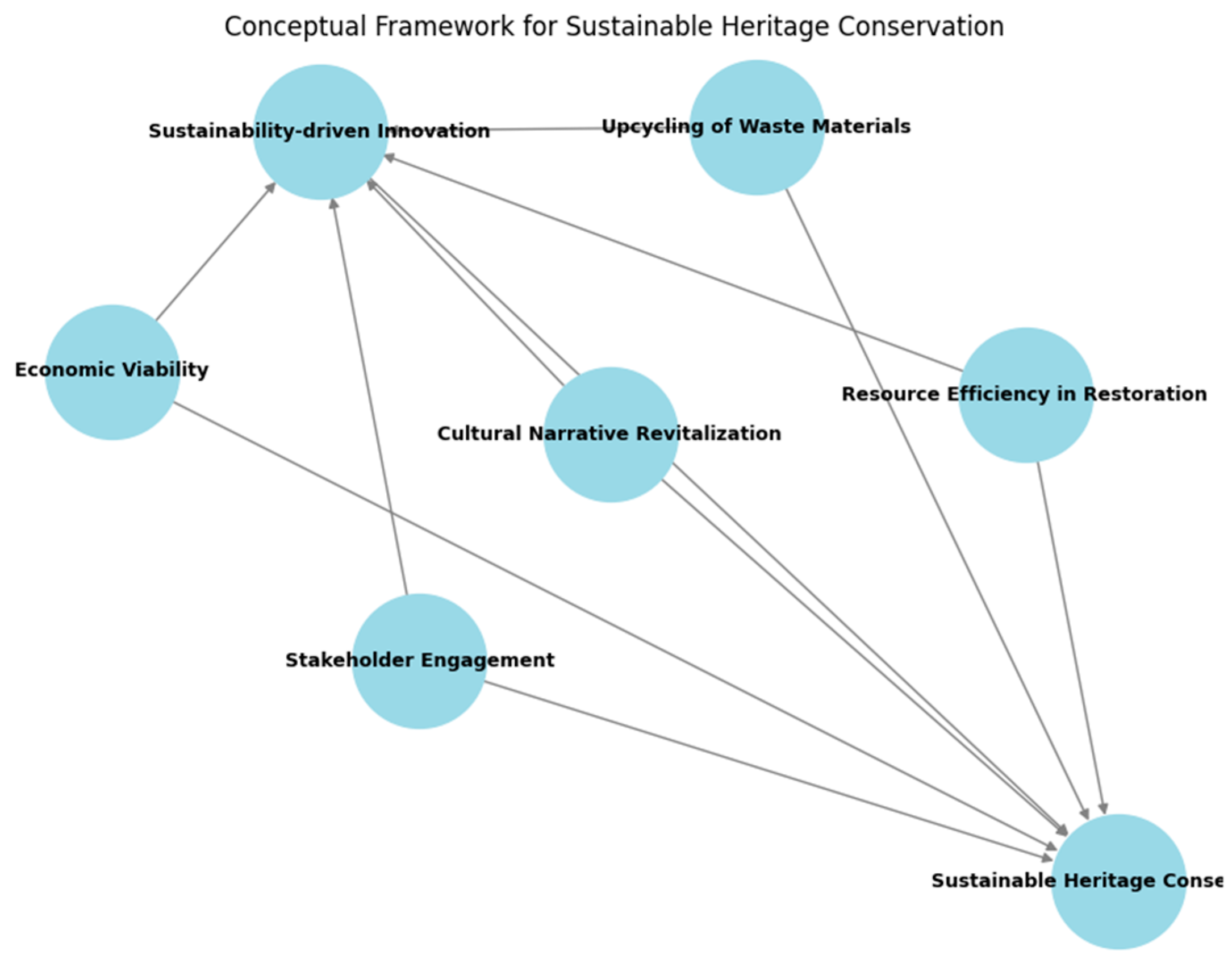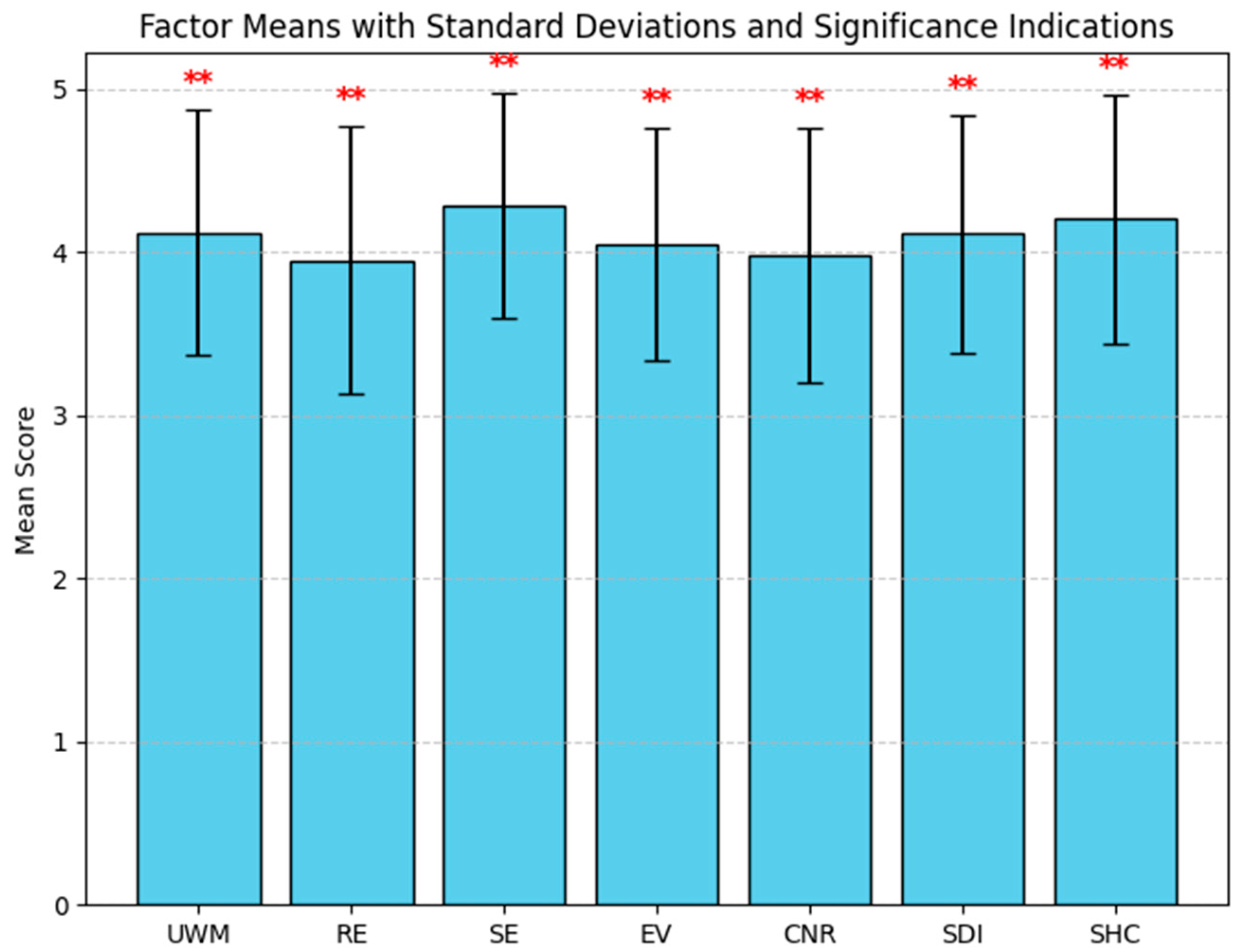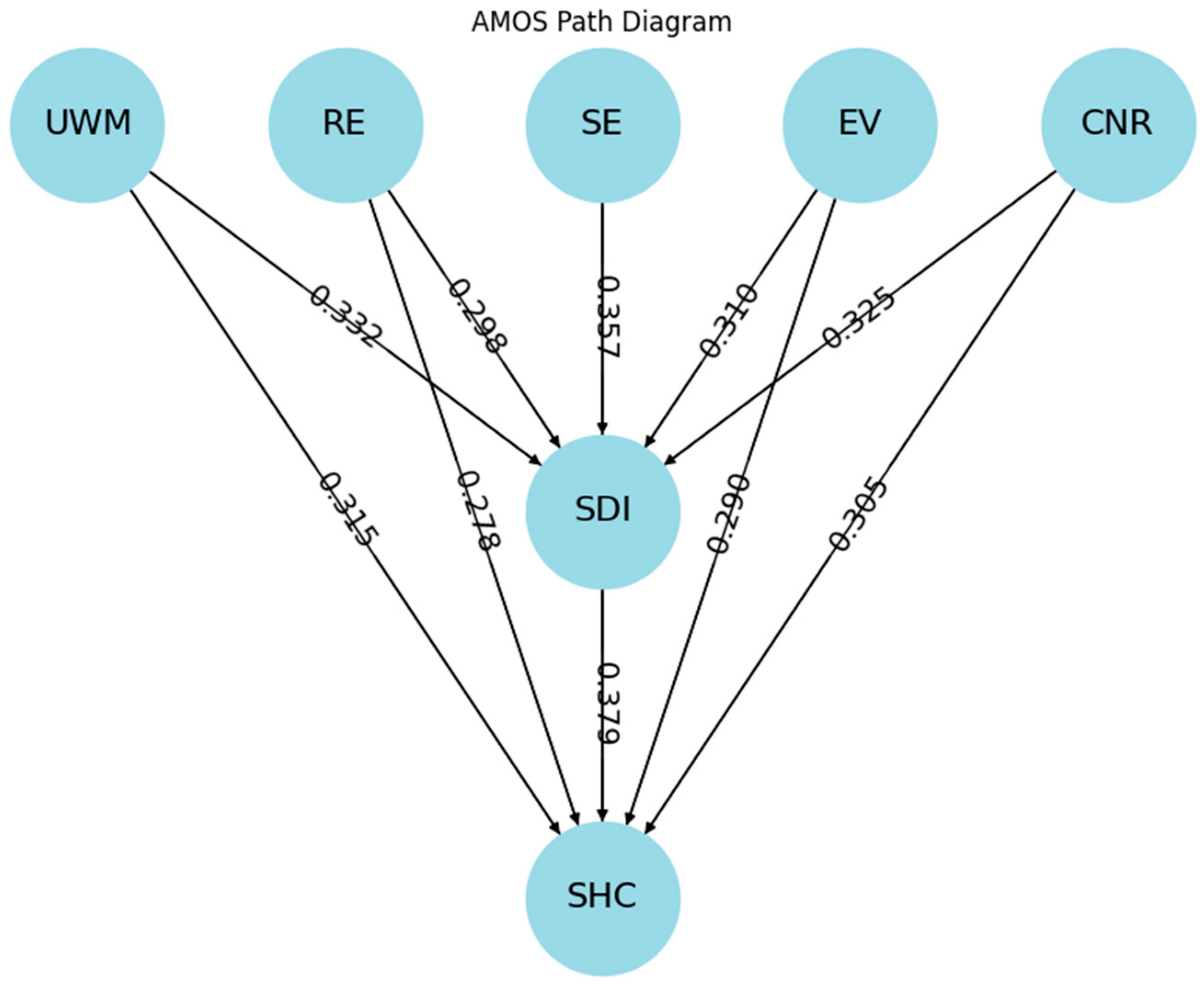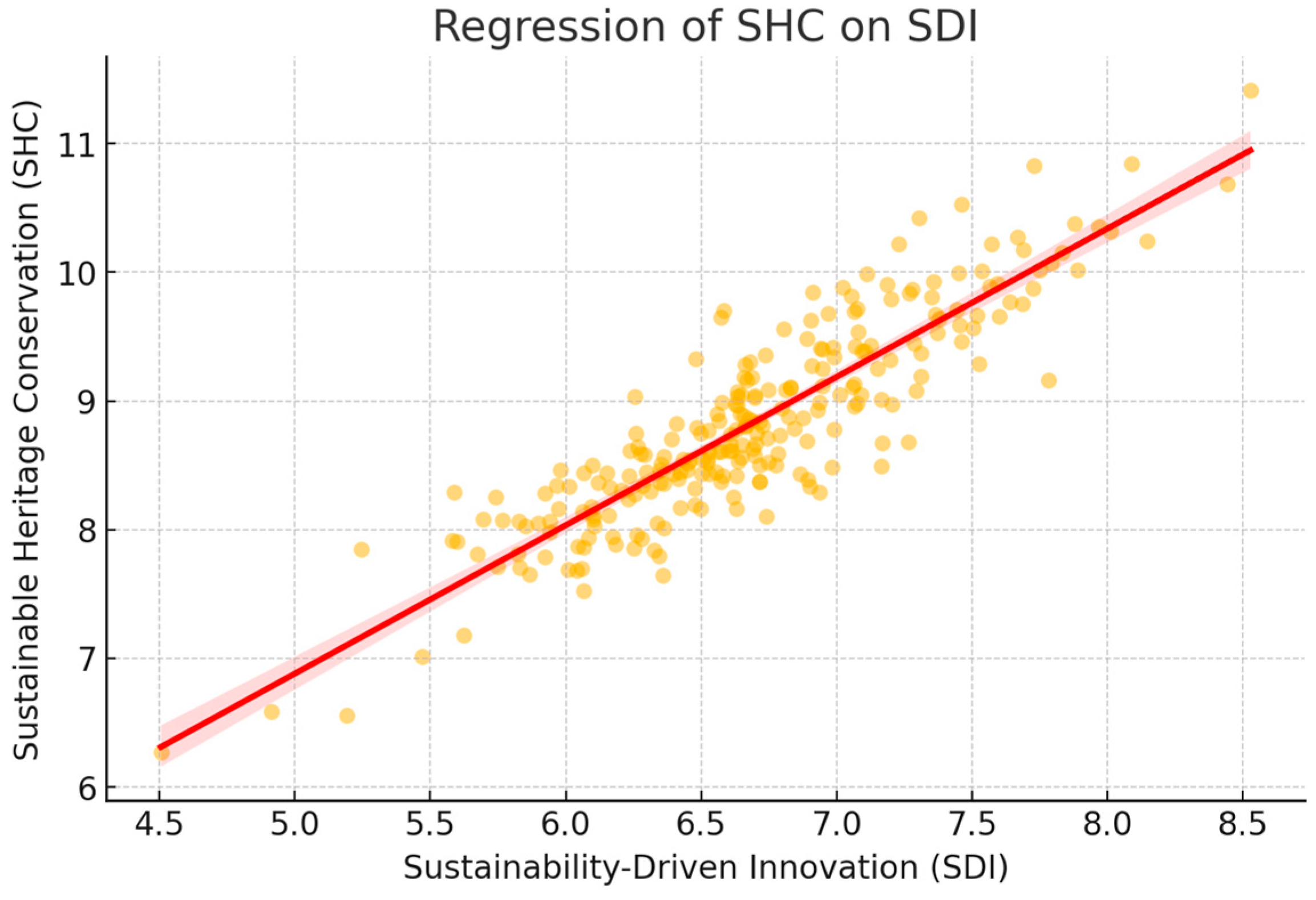Circular Economy in Chinese Heritage Conservation: Upcycling Waste Materials for Sustainable Restoration and Cultural Narrative Revitalization
Abstract
1. Introduction
- How does the use of upcycled waste materials in heritage conservation contribute to sustainable environmentalism by reducing waste and resource consumption?
- What are the economic and financial implications of applying circular economy principles in the restoration of heritage sites against conventional conservation methods?
- In terms of cultural sustainability, how does upcycling in heritage conservation protect historical narratives and engage local communities?
Theoretical Framework and Hypothesis Development
2. Literature Review
3. Research Methodology
3.1. Direct Effects Model
- SHC = Sustainable Heritage Conservation
- UWM = Upcycling of Waste Materials
- RE = Resource Efficiency in Restoration
- SE = Stakeholder Engagement in Circular Conservation
- EV = Economic Viability of Circular Practices
- CNR = Cultural Narrative Revitalization
- β_0 = Intercept
- β_1, β_2, β_3, β_4, β_5 = Regression coefficients
- ϵ = Error term.
3.2. Mediating Model (Sustainability-Driven Innovation as Mediator)
- Step 1: Regression of SDI on Independent Variables
- SDI = Sustainability-Driven Innovation
- α_0 = Intercept
- α_1, α_2, α_3, α_4, α_5 = Regression coefficients
- μ = Error term
- Step 2: Regression of SHC on Independent Variables and SDI.
- γ_6 Denotes the impact of SDI on SHC.
4. Results
4.1. Quantitative Study
- Direct effect
- Mediating effect
4.2. Case Study
5. Discussion
5.1. Circular Economy in Heritage Conservation: A Multi-Dimensional Approach
5.2. Stakeholder Engagement and Economic Viability in Heritage Conservation
5.3. Cultural Narrative Revitalization and Sustainability-Driven Innovation
5.4. Implications for the Circular Economy and Sustainable Development Goals
6. Conclusions
Author Contributions
Funding
Institutional Review Board Statement
Informed Consent Statement
Data Availability Statement
Conflicts of Interest
References
- Wainwright, O. Architect Dong Gong and China’s Rampant Urban Growth. The Guardian, 11 November 2024. Available online: https://www.theguardian.com/artanddesign/2024/nov/11/architect-dong-gong-china-rampant-urban (accessed on 9 April 2025).
- Guo, H.; Bai, B. Cultural inheritance and application of Yungang Grottoes statues in art education. ArtsEduca 2024, 38, 287. [Google Scholar]
- Wainwright, O. Liu Jiakun Wins Pritzker Prize. The Guardian, 4 March 2025. Available online: https://www.theguardian.com/artanddesign/2025/mar/04/liu-jiakun-winner-pritzker-prize-chinese (accessed on 9 April 2025).
- Zhu, Y.; Song, J.; Bai, Y. China’s Urban Regeneration Evolution from 1949 to 2022: From the Perspective of Governance Mode. Land 2024, 13, 1806. [Google Scholar] [CrossRef]
- Zhang, A.; Venkatesh, V.G.; Wang, J.X.; Mani, V.; Wan, M.; Qu, T. Drivers of Industry 4.0-Enabled Smart Waste Management in Supply Chain Operations: A Circular Economy Perspective in China. Prod. Plan. Control 2023, 34, 870–886. [Google Scholar] [CrossRef]
- Tao, L.; Wei, Q. Touched by the Past? Re-Articulating the Longxing Temple Sites as Community Heritage at Qingzhou County, China. Archaeologies 2021, 17, 285–302. [Google Scholar] [CrossRef]
- Ma, W.; Liu, T.; Hao, J.L.; Wu, W.; Gu, X. Towards a Circular Economy for Construction and Demolition Waste Management in China: Critical Success Factors. Sustain. Chem. Pharm. 2023, 35, 101226. [Google Scholar] [CrossRef]
- Ma, W.; Hao, J.L.; Zhang, C.; Di Sarno, L.; Mannis, A. Evaluating Carbon Emissions of China’s Waste Management Strategies for Building Refurbishment Projects: Contributing to a Circular Economy. Environ. Sci. Pollut. Res. 2023, 30, 8657–8671. [Google Scholar] [CrossRef] [PubMed]
- Di, K.; Chen, W.; Zhang, X.; Shi, Q.; Cai, Q.; Li, D.; Liu, C.; Di, Z. Regional Unevenness and Synergy of Carbon Emission Reduction in China’s Green Low-Carbon Circular Economy. J. Clean. Prod. 2023, 420, 138436. [Google Scholar] [CrossRef]
- Gravagnuolo, A.; Angrisano, M.; Bosone, M.; Buglione, F.; De Toro, P.; Girard, L.F. Participatory Evaluation of Cultural Heritage Adaptive Reuse Interventions in the Circular Economy Perspective: A Case Study of Historic Buildings in Salerno (Italy). J. Urban Manag. 2024, 13, 107–139. [Google Scholar] [CrossRef]
- Dişli, G.; Ankaralıgil, B. Circular Economy in the Heritage Conservation Sector: An Analysis of Circularity Degree in Existing Buildings. Sustain. Energy Technol. Assess. 2023, 56, 103126. [Google Scholar] [CrossRef]
- Çetin, S.; Kirchherr, J. The Build Back Circular Framework: Circular Economy Strategies for Post-Disaster Reconstruction and Recovery. Circ. Econ. Sustain. 2025, 1–38. [Google Scholar] [CrossRef]
- Baiani, S.; Altamura, P.; Turchetti, G. Circular Contemporary Heritage. Design Experimentations on Conservation and Reuse Aiming at Material Resource Efficiency and Decarbonization. In Contemporary Heritage Lexicon; Springer Nature: Cham, Switzerland, 2024; Volume 2, pp. 435–478. [Google Scholar]
- Mhatre, P.; Gedam, V.; Unnikrishnan, S.; Verma, S. Circular Economy in the Built Environment—Literature Review and Theory Development. J. Build. Eng. 2021, 35, 101995. [Google Scholar] [CrossRef]
- Wei, Y.; Yuan, H.; Li, H. Exploring the Contribution of Advanced Systems in Smart City Development for the Regeneration of Urban Industrial Heritage. Buildings 2024, 14, 583. [Google Scholar] [CrossRef]
- Stanojev, J.; Gustafsson, C. Smart Specialization Strategies for Elevating Integration of Cultural Heritage into the Circular Economy. Sustainability 2021, 13, 3685. [Google Scholar] [CrossRef]
- Lucchi, E.; Turati, F.; Colombo, B.; Schito, E. Climate-Responsive Design Practices: A Transdisciplinary Methodology for Achieving Sustainable Development Goals in Cultural and Natural Heritage. J. Clean. Prod. 2024, 457, 142431. [Google Scholar] [CrossRef]
- Fariza, P. Human Sustainable Cities Towards the SDGs and Green, Just, Smart and Inclusive Transitions by Voula Mega. WIMAYA 2023, 4, 125–126. [Google Scholar] [CrossRef]
- Zhou, G.; Gu, Y.; Wu, Y.; Gong, Y. Temporal Evolution of Environmental Impact Arising from Municipal Solid Waste Treatment Systems: A Case Study of Guangzhou, China. Systems 2024, 13, 12. [Google Scholar] [CrossRef]
- Xia, S.; Liu, B.; Wang, H. Construction of a Sustainability-Based Building Attribute Conservation Assessment Model in Historic Areas. Buildings 2022, 12, 1346. [Google Scholar] [CrossRef]
- Galluccio, G.; Deal, B.; Brooks, R.; Russo Ermolli, S.; Rigillo, M.; Perriccioli, M.; Esposito De Vita, G.; Bevilacqua, C. Design for Resilient Post-Disaster Wood Waste Upcycling. Buildings 2024, 14, 2065. [Google Scholar] [CrossRef]
- Kandpal, V.; Jaswal, A.; Santibanez Gonzalez, E.D.; Agarwal, N. Circular Economy Principles: Shifting Towards Sustainable Prosperity. In Sustainable Energy Transition: Circular Economy and Sustainable Financing for ESG Practices; Springer Nature: Cham, Switzerland, 2024; pp. 125–165. [Google Scholar]
- World Bank. Waste Management and Circular Economy. World Bank Open Knowledge Repository. 2019. Available online: https://openknowledge.worldbank.org (accessed on 9 April 2025).
- Mulhern, O. Waste Management in China and the US. Earth.org., 22 January 2021. Available online: https://earth.org/data_visualization/waste-management-china-and-the-us (accessed on 9 April 2025).
- Labadi, S.; Giliberto, F.; Rosetti, I.; Shetabi, L.; Yildirim, E. Heritage and the Sustainable Development Goals: Policy Guidance for Heritage and Development Actors. Available online: https://kar.kent.ac.uk/89231/1/ICOMOS_SDGs_Policy_Guidance_2021.pdf (accessed on 9 April 2025).
- Lowenthal, D. The Heritage Crusade and the Spoils of History; Cambridge University Press: Cambridge, UK, 1998. [Google Scholar]
- Sharma, H.B.; Vanapalli, K.R.; Samal, B.; Cheela, V.S.; Dubey, B.K.; Bhattacharya, J. Circular Economy Approach in Solid Waste Management System to Achieve UN-SDGs: Solutions for Post-COVID Recovery. Sci. Total Environ. 2021, 800, 149605. [Google Scholar] [CrossRef]
- Nocca, F. The Role of Cultural Heritage in Sustainable Development: Multidimensional Indicators as a Decision-Making Tool. Sustainability 2017, 9, 1882. [Google Scholar] [CrossRef]
- Mason, R. Values and Sustaining Heritage. In Routledge Handbook of Sustainable Heritage; Routledge: London, UK, 2022; pp. 17–29. [Google Scholar]
- Ghisellini, P.; Cialani, C.; Ulgiati, S. A Review on Circular Economy: The Expected Transition to a Balanced Interplay of Environmental and Economic Systems. J. Clean. Prod. 2016, 114, 11–32. [Google Scholar] [CrossRef]
- Rodwell, D. Sustainability and the Holistic Approach to the Conservation of Historic Cities. J. Archit. Conserv. 2003, 9, 58–73. [Google Scholar] [CrossRef]
- Blagojević, M.R.; Tufegdžić, A. The New Technology Era Requirements and Sustainable Approach to Industrial Heritage Renewal. Energy Build. 2016, 115, 148–153. [Google Scholar] [CrossRef]
- Johansson, M. Reimagining EU Trademark Law in an Upcycling Era—A Circular Economy Approach. Vic. Univ. Wellingt. Law Rev. 2009, 40, 293–310. [Google Scholar]
- Duflou, J.R.; Sutherland, J.W.; Dornfeld, D.; Herrmann, C.; Jeswiet, J.; Kara, S.; Hauschild, M.; Kellens, K. Towards Energy and Resource Efficient Manufacturing: A Processes and Systems Approach. CIRP Ann. 2012, 61, 587–609. [Google Scholar] [CrossRef]
- Violano, A.; Maio, A. The Regeneration of Architectural Heritage to Manage the Reversibility of Adaptive Reuse Technology Design: Two Italian Case Studies. In ETHICS: Endorse Technologies for Heritage Innovation: Cross-Disciplinary Strategies; Springer Nature: Cham, Switzerland, 2024; pp. 209–226. [Google Scholar]
- Pan, Y.; Hashemizadeh, A. Circular Economy-Based Assessment Framework for Enhancing Sustainability in Renewable Energy Development with Life Cycle Considerations. Environ. Impact Assess. Rev. 2023, 103, 107289. [Google Scholar] [CrossRef]
- El Agamy Abdelkader, A. Innovation to Sustainability in Design. Int. J. Des. Fash. Stud. 2023, 6, 55–68. [Google Scholar] [CrossRef]




| Demographic Variable | Category | Frequency (N) | Percentage (%) | Chi-Square (χ2) Significance |
|---|---|---|---|---|
| Gender | Male | 150 | 60% | 0.032 (Sig.) |
| Female | 100 | 40% | ||
| Age Group | 18–30 | 80 | 32% | 0.045 (Sig.) |
| 31–45 | 120 | 48% | ||
| 46+ | 50 | 20% | ||
| Education Level | High School | 50 | 20% | 0.021 (Sig.) |
| Bachelor’s | 120 | 48% | ||
| Master’s/Ph.D. | 80 | 32% |
| Factor | Mean (M) | Standard Deviation (SD) | t-Test Significance (p-Value) |
|---|---|---|---|
| Upcycling Waste Materials (UWM) | 4.12 | 0.75 | 0.018 (Sig.) |
| Resource Efficiency (RE) | 3.95 | 0.82 | 0.022 (Sig.) |
| Stakeholder Engagement (SE) | 4.28 | 0.69 | 0.011 (Sig.) |
| Economic Viability (EV) | 4.05 | 0.71 | 0.015 (Sig.) |
| Cultural Narrative Revitalization (CNR) | 3.98 | 0.78 | 0.019 (Sig.) |
| Sustainability-Driven Innovation (SDI) | 4.11 | 0.73 | 0.014 (Sig.) |
| Sustainable Heritage Conservation (SHC) | 4.20 | 0.76 | 0.009 (Sig.) |
| Construct | UWM | RE | SE | EV | CNR | SDI | SHC |
|---|---|---|---|---|---|---|---|
| UWM | 0.812 | ||||||
| RE | 0.532 | 0.835 | |||||
| SE | 0.498 | 0.521 | 0.849 | ||||
| EV | 0.412 | 0.465 | 0.502 | 0.821 | |||
| CNR | 0.467 | 0.471 | 0.532 | 0.489 | 0.832 | ||
| SDI | 0.515 | 0.498 | 0.548 | 0.517 | 0.558 | 0.827 | |
| SHC | 0.480 | 0.522 | 0.564 | 0.490 | 0.503 | 0.569 | 0.841 |
| Fit Index | Threshold | Model Fit Value | Interpretation |
| Chi-Square (χ2/df) | <3.0 | 2.41 | Acceptable Fit |
| Goodness of Fit Index (GFI) | ≥0.90 | 0.928 | Good Fit |
| Comparative Fit Index (CFI) | ≥0.90 | 0.951 | Good Fit |
| Root Mean Square Error of Approximation (RMSEA) | ≤0.08 | 0.054 | Good Fit |
| Standardized Root Mean Square Residual (SRMR) | ≤0.08 | 0.048 | Good Fit |
| Path | Standardized β | t-Value | p-Value | Result |
|---|---|---|---|---|
| UWM → SHC | 0.315 | 4.21 | 0.000 | H1 Supported |
| RE → SHC | 0.278 | 3.94 | 0.001 | H2 Supported |
| SE → SHC | 0.340 | 4.57 | 0.000 | H3 Supported |
| EV → SHC | 0.290 | 3.87 | 0.002 | H4 Supported |
| CNR → SHC | 0.305 | 4.11 | 0.000 | H5 Supported |
| UWM → SDI | 0.332 | 4.38 | 0.000 | H6 Supported |
| RE → SDI | 0.298 | 4.02 | 0.001 | |
| SE → SDI | 0.357 | 4.72 | 0.000 | |
| EV → SDI | 0.310 | 4.19 | 0.000 | |
| CNR → SDI | 0.325 | 4.31 | 0.000 | |
| SDI → SHC | 0.379 | 4.82 | 0.000 |
Disclaimer/Publisher’s Note: The statements, opinions and data contained in all publications are solely those of the individual author(s) and contributor(s) and not of MDPI and/or the editor(s). MDPI and/or the editor(s) disclaim responsibility for any injury to people or property resulting from any ideas, methods, instructions or products referred to in the content. |
© 2025 by the authors. Licensee MDPI, Basel, Switzerland. This article is an open access article distributed under the terms and conditions of the Creative Commons Attribution (CC BY) license (https://creativecommons.org/licenses/by/4.0/).
Share and Cite
Cao, W.; Zhang, Y.; Liu, J. Circular Economy in Chinese Heritage Conservation: Upcycling Waste Materials for Sustainable Restoration and Cultural Narrative Revitalization. Sustainability 2025, 17, 3442. https://doi.org/10.3390/su17083442
Cao W, Zhang Y, Liu J. Circular Economy in Chinese Heritage Conservation: Upcycling Waste Materials for Sustainable Restoration and Cultural Narrative Revitalization. Sustainability. 2025; 17(8):3442. https://doi.org/10.3390/su17083442
Chicago/Turabian StyleCao, Wei, Yaqi Zhang, and Jian Liu. 2025. "Circular Economy in Chinese Heritage Conservation: Upcycling Waste Materials for Sustainable Restoration and Cultural Narrative Revitalization" Sustainability 17, no. 8: 3442. https://doi.org/10.3390/su17083442
APA StyleCao, W., Zhang, Y., & Liu, J. (2025). Circular Economy in Chinese Heritage Conservation: Upcycling Waste Materials for Sustainable Restoration and Cultural Narrative Revitalization. Sustainability, 17(8), 3442. https://doi.org/10.3390/su17083442







